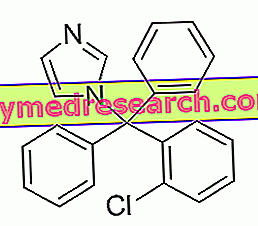Clotrimazole is an azole-type antifungal drug. It is very useful in the treatment of fungal infections of the skin and vaginal mycoses, in fact, it is available in the form of pharmaceutical formulations suitable for skin use and vaginal use.

Clotrimazole - Chemical Structure
Clotrimazole cannot be taken orally, since it is capable of inducing neuropsychic toxicity.
Indications
For what it uses
Clotrimazole for cutaneous use is indicated for the treatment of:
- Pityriasis versicolor;
- Cutaneous candidiasis;
- Tinea pedis;
- Tinea corporis.
Clotrimazole for vaginal use, on the other hand, is indicated for the treatment of:
- Vulvovaginal infections caused by Candida.
Warnings
Prolonged use of clotrimazole for topical (both cutaneous and vaginal) use can give rise to sensitization phenomena that can manifest with symptoms such as localized and itchy redness. If this occurs, treatment with clotrimazole should be stopped immediately.
Before starting treatment with clotrimazole (for cutaneous use or for vaginal use) it is necessary to inform your doctor if you suffer from relapses of mycoses.
The use of clotrimazole for vaginal use may decrease the effectiveness of latex-containing contraceptives.
Interactions
There are no known drug interactions between cutaneous clotrimazole and other drugs.
In the case of treatment with clotrimazole for vaginal use, on the other hand, it is necessary to inform the doctor if you are already being treated with sirolimus or tacrolimus orally (immunosuppressive drugs used to prevent rejection in organ transplants), since clotrimazole for use vaginal discharge may increase the plasma concentration of these drugs.
In any case, it is still advisable to inform your doctor if you are taking - or have recently been taken - drugs of any kind, including medicines without a medical prescription and herbal and / or homeopathic products.
Side effects
Clotrimazole can trigger various side effects, although not all patients experience them. This depends on the different sensitivity that each individual has towards the drug. Therefore, it is not said that all adverse effects occur with the same intensity in each person.
The main side effects that may occur during treatment with clotrimazole are listed below.
Allergic reactions
Clotrimazole can trigger allergic reactions in sensitive individuals. These reactions can occur with symptoms such as:
- Dyspnoea;
- Urticaria;
- Temporary loss of consciousness;
- Hypotension.
Skin and subcutaneous tissue disorders
Treatment with clotrimazole for cutaneous use may favor the appearance of:
- bubbles;
- Discomfort and / or pain at the application area;
- Irritation;
- Skin peeling;
- Itch;
- Burning;
- Skin eruptions.
Reproductive system disorders
Clotrimazole therapy for vaginal use may favor the onset of:
- Desquamation of the genital area;
- Skin eruptions;
- Itch;
- Swelling;
- Erythema;
- discomfort;
- Burning;
- Irritation;
- Vaginal bleeding;
- Pelvic pain.
Gastrointestinal disorders
Treatment with clotrimazole for vaginal use can also cause abdominal pain.
Overdose
No cases of intoxication have been reported in case of application of an overdose of clotrimazole for cutaneous use or for vaginal use.
In case of accidental ingestion of clotrimazole, it is necessary to contact the doctor immediately and go to the nearest hospital.
Action mechanism
Clotrimazole is an azole antifungal that performs its function by interfering with the synthesis of the sterol that constitutes the plasma membrane of fungal cells: ergosterol.
More precisely, clotrimazole (like all azole antifungals) inhibits one of the key enzymes of the synthesis of the aforementioned ergosterol, 14α-demethylase.
By inhibiting this enzyme there is an accumulation of ergosterol precursors inside the fungal cell.
The ergosterol precursors, when they reach too high concentrations inside the cell, become toxic for the cell itself and, moreover, cause alterations of the permeability of the cell membrane and alterations in the functioning of the proteins contained in it.
The fungal cell is thus condemned to meet a certain death.
Mode of Use - Posology
Clotrimazole is available as a cream, powder and spray for skin use and in the form of a cream and tablets for vaginal use.
During treatment with clotrimazole, it is very important to follow the doctor's instructions, both as regards the amount of drug to be used and the duration of the treatment itself.
Below are some indications on the doses of clotrimazole usually used in therapy.
Treatment of cutaneous mycoses
For the treatment of cutaneous mycoses, it is recommended to apply clotrimazole for cutaneous use 2-3 times a day, in correspondence with the areas affected by the infection. Treatment should be continued for at least two weeks after the symptoms have disappeared.
Treatment of vaginal mycoses
For the treatment of vaginal mycoses, it is recommended to apply clotrimazole for vaginal use for three consecutive days before going to bed. The doctor, if he deems it necessary, may decide to increase the duration of the treatment.
Clotrimazole for vaginal use should not be used in children under 12 years of age.
Pregnancy and breastfeeding
Before taking clotrimazole, pregnant women and breastfeeding mothers should definitely seek medical advice.
Generally, as a precautionary measure, it is recommended not to use clotrimazole during the first trimester of pregnancy.
At the same time, it is advised to stop breast-feeding during therapy with clotrimazole, as this may be excreted in breast milk.
Contraindications
The use of clotrimazole is contraindicated in patients with known hypersensitivity to the extended clotrimazole.


